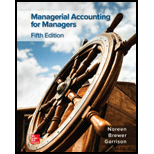
Concept introduction:
First stage allocations:
The financial statement of the company classifies the cost department wise. Therefore, it is necessary to allocate the cost to different activities in order to build a relationship between the activity and the costing.
Requirement 1:
Prepare a report showing the first-stage allocation of the costs to the activity cost pools.
Concept introduction:
Activity rate:
The activity rate is determined by dividing the net activity cost, with the total number of activities. The calculation of the activity rate is the second step in the implementation of activity-based costing. After establishing the relationship between the overheads and the activity, the management has to ascertain the activity rate for that specific activity.
Requirement 2:
Calculate the activity rate for the given activity cost pools.
Concept introduction:
Activity-based costing (ABC):
Activity-based costing refers to the method of costing where the overhead cost is assigned to various products. This costing method identifies the relationship between the
Requirement 3:
Calculate the total cost and the average cost of the given jobs.
Concept introduction:
Activity-based costing (ABC):
Activity-based costing refers to the method of costing where the overhead cost is assigned to various products. This costing method identifies the relationship between the manufacturing overhead costs and the activities. After establishing the relationship, the indirect cost is allocated to the products.
Requirement 4:
Explain whether the present policy of binding of jobs is reasonable.
Want to see the full answer?
Check out a sample textbook solution
Chapter 5 Solutions
Managerial Accounting for Managers
- Kraft's contribution margin is 35%. The company is contemplating an advertising campaign that will cost $18,450. If sales are expected to increase $72,800, by how much will the company's net income increase?arrow_forwardPlease provide the answer to this general accounting question using the right approach.arrow_forwardThe Patidar Group manufactures and sells a single product, Product T. Budgeted sales for June are $450,000. Gross Margin is budgeted at 35% of sales dollars. If the net income for June is budgeted at $62,500, the budgeted selling and administrative expenses are? HELParrow_forward
- General accountingarrow_forwardDelta's inventory records for February reflect the following details: On February 1, the beginning inventory consisted of 250 units priced at $3.20 each. On February 9, Delta made its first purchase of 350 units at a cost of $3.50 each. A second purchase was made on February 18, consisting of 500 units priced at $3.70 each. By the end of the month, on February 28, Delta sold 700 units at a price of $6.50 per unit. Using the FIFO (First-In, First-Out) cost flow method, what is the cost of goods sold (COGS) for February?arrow_forwardPlease explain the solution to this general accounting problem with accurate principles.arrow_forward
- Please explain how to solve this financial accounting question with valid financial principles.arrow_forwardVeloid Ltd. has Assets of $312,480 and Liabilities of $95,165. The firm has 11,920 shares of stock outstanding. Then the board decides to pay a dividend of $10.50 per share. What is the value of Stockholders' Equity after the payment of the dividend?arrow_forwardShri Manufacturing has estimated total factory overhead costs of $625,000 and 25,000 direct labor hours for the current fiscal year. If direct labor hours for the year total 23,500 and actual factory overhead totals $610,000, what is the amount of overapplied or underapplied overhead for the year? Helparrow_forward
- What is the correct answer with accounting questionarrow_forwardPlease solve this general accounting problem an given step by step explanationarrow_forwardBeacon Manufacturing has $85,000 in assets. They also have $32,000 in liabilities and $8,500 in expenses, and they paid out $6,200 in dividends this year. The extended accounting equation is assets = liabilities + (revenue - (expenses + dividends)). What would their revenue need to be for their accounts to be in balance?arrow_forward

 AccountingAccountingISBN:9781337272094Author:WARREN, Carl S., Reeve, James M., Duchac, Jonathan E.Publisher:Cengage Learning,
AccountingAccountingISBN:9781337272094Author:WARREN, Carl S., Reeve, James M., Duchac, Jonathan E.Publisher:Cengage Learning, Accounting Information SystemsAccountingISBN:9781337619202Author:Hall, James A.Publisher:Cengage Learning,
Accounting Information SystemsAccountingISBN:9781337619202Author:Hall, James A.Publisher:Cengage Learning, Horngren's Cost Accounting: A Managerial Emphasis...AccountingISBN:9780134475585Author:Srikant M. Datar, Madhav V. RajanPublisher:PEARSON
Horngren's Cost Accounting: A Managerial Emphasis...AccountingISBN:9780134475585Author:Srikant M. Datar, Madhav V. RajanPublisher:PEARSON Intermediate AccountingAccountingISBN:9781259722660Author:J. David Spiceland, Mark W. Nelson, Wayne M ThomasPublisher:McGraw-Hill Education
Intermediate AccountingAccountingISBN:9781259722660Author:J. David Spiceland, Mark W. Nelson, Wayne M ThomasPublisher:McGraw-Hill Education Financial and Managerial AccountingAccountingISBN:9781259726705Author:John J Wild, Ken W. Shaw, Barbara Chiappetta Fundamental Accounting PrinciplesPublisher:McGraw-Hill Education
Financial and Managerial AccountingAccountingISBN:9781259726705Author:John J Wild, Ken W. Shaw, Barbara Chiappetta Fundamental Accounting PrinciplesPublisher:McGraw-Hill Education





